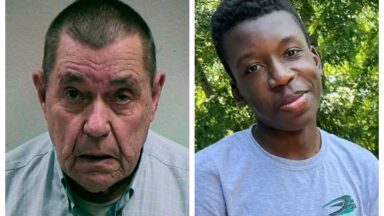Manhattan’s Chelsea neighborhood is well-known now as an arts center, home to the Whitney Museum of American Art, major galleries and the elevated High Line park. But in the ’70s, the Hudson Piers that run along its coast were an unofficial creative space and erotic playground where artists took over and transformed the large city-owned decaying buildings that had once been part of an active port.
“To wander among the pier ruins meant both to be aware of the past of a great maritime city and to sense an apocalyptic future,” wrote Jonathan Weinberg, art historian at Yale University and author of the book “Pier Groups” — a title he borrowed from a 1979 porn film by director Arch Brown that was shot on the Manhattan waterfront.
“Boy Climbs the Beams on Pier 48 Ruins” (1977) by Shelley Seccombe Credit: Shelley Seccombe Weinberg studied the rebirth of the city’s terminals for 15 years. The resulting book tells the story of the Manhattan docks, which were frequented by a diverse group of people (the author included). The ever-changing crowd included notable artists, like gay activist David Wojnarowicz, whose liberating experiences on the piers inspired his writing and paintings. But the piers also attracted men who were cruising for sex or looking to sunbathe nude and homeless people looking for shelter. According to the book, visitors to the piers discovered a safe haven for new forms of expression — even though walking on the run-down structures could be physically dangerous.
In doing so, they reclaimed disused buildings from their derelict fate, turning empty piers into community spaces teeming with creativity. “The adjective ‘abandoned’ is used again and again to describe these structures, and suggests emptiness — a place discarded, waiting to be rediscovered by the imaginative eye of an artist,” Weinberg wrote. “Yet the more I learned about the piers, the more they seemed crowded with activity.”
On the surface, the story of the Hudson Piers in the ’70s was salacious. But it’s also a case study in occupying public space to create a community that became synonymous with artistic and sexual freedom.
“Everybody who talks about (the piers) has this very personal relationship to them and felt like it was their place, that nobody else knew about it,” Weinberg said in a phone interview.
“Untitled (Pier 46)” (1983) by Morgan Gwenwald. Credit: Morgan Gwenwald
The late ’70s were a grim period for New York City, which was in crisis and on the verge of bankruptcy. In June 1975, tourists arriving in its airports were given pamphlets urging them to stay away from New York, which had been dubbed “Fear City.” As crime escalated, 1977 became its most violent year since the NYPD began compiling data, with a total of 658,147 reported serious crimes.
While undeniably bleak, the city was also bubbling with creativity, particularly in the wake of the Stonewall Uprising — the riots in 1969 which spurred the gay rights movement. Then, in 1973, when a section of the West Side Highway collapsed, the nearby docks were abandoned, becoming a breeding ground for newfound creative energy and romantic trysts.
“Sunbathers, Pier 51, Vertical, with Onlookers Above” (1977) by Shelley Seccombe Credit: Shelley Seccombe” (Artist) David Wojnarowicz saw (the piers) as incredibly romantic and beautiful,” said Weinberg, adding the artist saw the ruins as an image of a crumbling dystopian future that could happen anywhere. “And for a lot of men…there’s a kind of thrill in having sex outside, in a dangerous place.”
While the pier ruins were a popular refuge, they also hid many dangers. “As much as you read about it, you can’t really understand how frightening it would be to go into a space like that in the middle of the night,” said Weinberg. One man was injured when he fell from a ramp, while another was bitten by a rat, according to Weinberg. On one occasion, photographer Alvin Baltrop captured a body that had been found in the water. Despite the dangers, men rarely called the police, because they were afraid of their response or of their sexuality being exposed.



Recent Comments